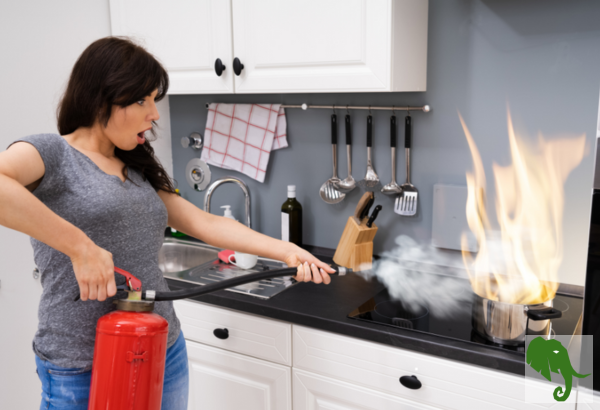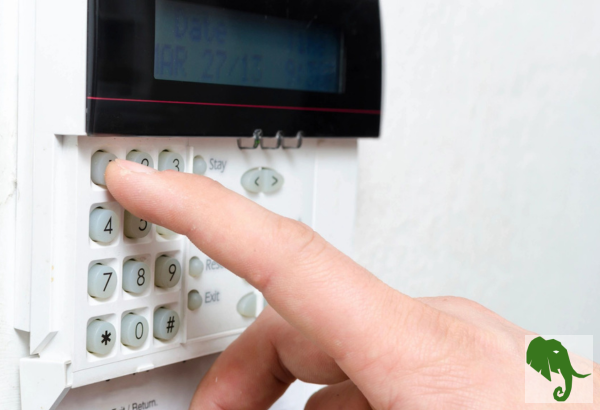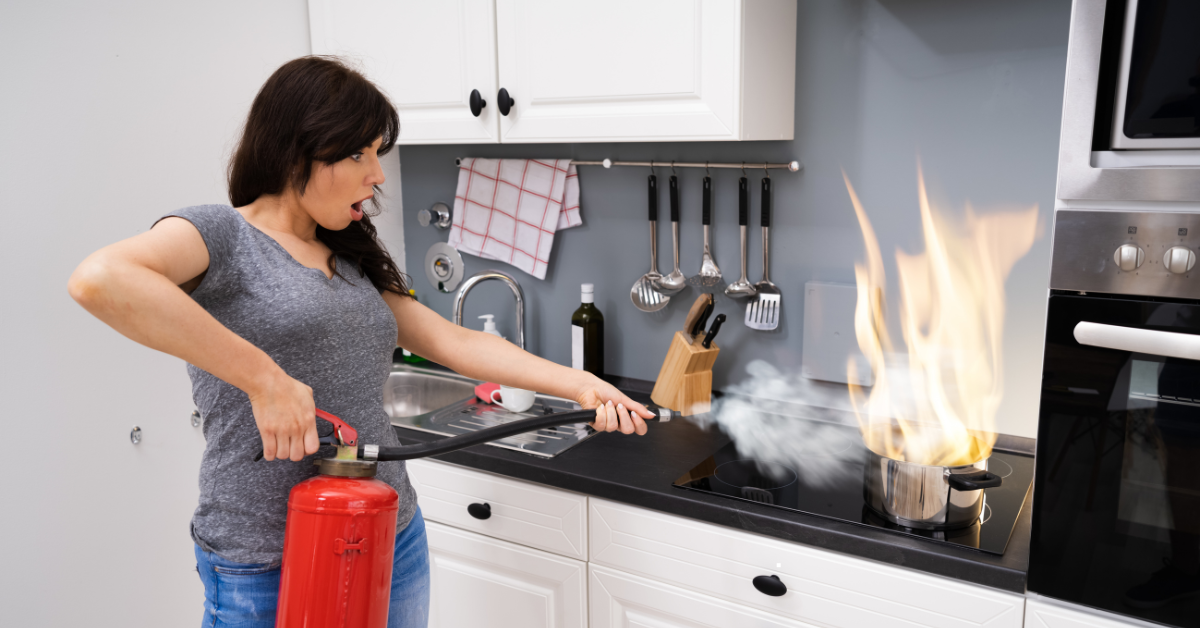
Have you ever experienced a grease fire while cooking, only to realize you weren’t prepared to put it out? Maybe you tried using water and quickly learned that wasn’t a good idea. Many of us overlook the importance of having a fire extinguisher at home, thinking we’ll never need it—until we do. Portable fire extinguishers are easy to use, widely available, and highly effective when used correctly. However, it’s essential to know some basic information about fire extinguishers and how to use them properly. In this post, we’ll cover fire class types, the corresponding fire extinguishers, how to use them, and where to place them in your home. Let’s get started.
Understanding Fire and Its Elements
To effectively combat a fire, it’s important to understand how fire works. Four elements must be present for a fire to exist: oxygen, heat, fuel, and a chemical reaction between these three elements. Remove any one of these, and the fire will be extinguished. Fire extinguishers work by eliminating or disrupting one or more of these elements.
Oxygen is necessary to sustain combustion, which is why fires continue to burn in open spaces. By reducing or cutting off the oxygen supply, such as covering a small fire with a non-flammable object, you can extinguish the fire.
Heat is required to raise the material to its ignition temperature. If you cool down the burning material, like using water to lower the temperature of burning wood, the fire will eventually die out.
Fuel provides the material necessary to sustain combustion. Common fuels include wood, paper, oil, and gas. Removing the fuel source, like shutting off the gas line to a stove, will stop the fire from continuing.
Finally, the chemical reaction occurs when oxygen, heat, and fuel interact, causing combustion. Fire extinguishers are designed to disrupt this reaction by either cooling the burning material, cutting off the oxygen supply, or interrupting the chemical reaction itself.
Fire Class Types
Not all fires are the same—the key difference lies in the fuel source. Understanding the fire class helps you choose the right extinguisher:
- Class A – Trash, wood, paper: Fueled by ordinary combustibles like wood, paper, cloth, trash, and plastics. Class A fires are the most common type of fire encountered in homes and workplaces.
- Class B – Liquids: Fueled by flammable liquids such as gasoline, oil, and paint. This class also includes flammable gases like propane and butane but does not include cooking oils or grease. An example of a Class B fire could be a gasoline spill igniting in a garage or a propane leak catching fire.
- Class C – Electrical equipment: Involves energized electrical equipment like motors, transformers, and appliances. If the power is cut, a Class C fire becomes another class of fire. It’s critical to ensure that the power is shut off before attempting to extinguish this type of fire, as using the wrong extinguisher could cause electrocution.
- Class D – Combustible metals: Fueled by combustible metals such as potassium, sodium, aluminum, and magnesium. Class D fires are not as common in residential settings but can occur in industrial or laboratory environments where these metals are present.
- Class K – Cooking oils, fats, grease: Specifically for fires fueled by cooking oils and greases, such as animal and vegetable fats. These fires are commonly found in commercial kitchens or during home cooking, particularly when frying.
Although Class K fires might seem the most common, especially given their association with kitchen activities, Class A fires actually occur more frequently because they involve everyday materials. These fires can start from simple activities like improperly disposing of a cigarette or ash, and they can spread quickly if the conditions are right. For example, a small spark from a fireplace could easily ignite nearby newspapers or a stack of firewood, leading to a rapidly growing Class A fire.
Types of Fire Extinguishers
It’s a common misconception that all fire extinguishers work the same or can be used on any fire. As much as I am embarrassed to admit to it, I once thought that all fire extinguishers worked the same. In reality, different fire extinguishers are designed for specific types of fires:
- Water extinguishers: Effective for Class A fires only.
- Foam extinguishers: Suitable for Class A & B fires.
- Carbon dioxide extinguishers: Effective on Class B & C fires, but usually ineffective on Class A fires.
- Halon 1211 (Clean agent) extinguishers: Can be used on Class A, B, and C fires.
- Dry chemical extinguishers: The most commonly used, effective on Class A, B, and C fires.
- Wet chemical extinguishers: Best for Class A and K fires.
- Dry powder extinguishers: Intended for Class D fires, working by separating the fuel from oxygen and removing heat.
Before purchasing a fire extinguisher, be sure to consider how you plan to use it and verify its rating. Some extinguishers are rated for multiple fire classes, while others are specific to a single class. Always read the label and warnings carefully to ensure you are equipped to handle the specific fire risks in your environment.
Properly Using a Fire Extinguisher
Now that you understand fire classes and the types of extinguishers, it’s important to learn how to use them properly. The acronym PASS can help you remember the steps:
- Pull: Pull the pin to break the tamper seal and unlock the operating lever. The pin prevents accidental discharge and must be removed before you can operate the extinguisher.
- Aim: Point the nozzle or hose at the base of the fire, not the flames. Aiming at the base is more effective as it targets the fire’s fuel source. By directing the extinguishing agent at the material that is burning, you can more effectively stop the fire.
- Squeeze: Squeeze the handle or lever slowly to discharge the extinguishing agent. Don’t release the lever until the fire is out. Applying a controlled, steady pressure ensures that you use the extinguisher effectively without wasting the agent.
- Sweep: Sweep the nozzle back and forth across the base of the fire while moving closer. Continue until the flames are extinguished. This sweeping motion ensures that the extinguishing agent covers the entire area of the fire and prevents it from spreading to nearby materials.
If the fire reignites, repeat steps 2–4. Always operate the extinguisher from a safe distance, keeping your back to an exit in case the fire becomes uncontrollable. If it does, evacuate immediately and call 911.
Using a fire extinguisher is a skill that requires practice. Consider taking a formal class, watching instructional videos, or practicing with an inexpensive or refillable extinguisher.
Where to Place Your Fire Extinguisher
Once you’ve purchased a fire extinguisher, place it in a common area or along a traveled path for easy access during an emergency. Avoid storing it under the sink or in a closet where it may be difficult to reach. Instead, mount it on a wall near an exit, in the kitchen, or close to the hot water heater, about five feet off the ground. If your home has multiple levels, consider placing an extinguisher on each level. Additionally, if you work in the garage or have specific fire hazards, consider purchasing extinguishers rated for those specific risks.
Conclusion
Understanding the proper use of fire extinguishers is crucial for ensuring safety in your home. By familiarizing yourself with the different fire classes, choosing the appropriate extinguisher, and learning how to effectively operate it, you can significantly reduce the risk of a fire escalating into a dangerous situation. Remember, preparation is key. Take the time to practice using your fire extinguisher, and make sure it’s easily accessible in case of an emergency.
Additionally, consider integrating fire safety into your overall home safety plan. This might include installing smoke alarms, planning escape routes, and having regular fire drills with your family. Your readiness could make all the difference in protecting your home and loved ones from fire. A fire extinguisher is a valuable tool, but it’s only one part of a comprehensive fire safety strategy. Stay informed, stay prepared, and stay safe.
Related Content

Office Safety and Security Considerations
Ensuring safety in the workplace is not just the responsibility of management or safety officers; it is a collective responsibility that each employee should take seriously. Familiarizing …

Enhancing Security Inside Your Home
This is the second post in our series on making your home safer. We covered making the exterior of your home more secure in our first …

Read other OwnGuard Solutions blog posts
Read our other posts centered around being safer and better prepared.

